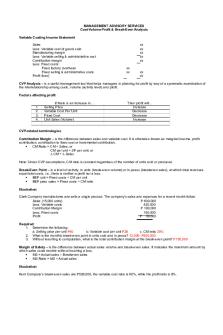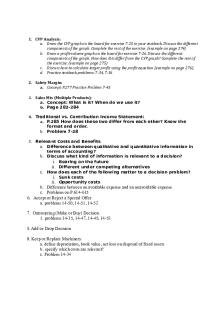Additional Practices for CVP PDF

| Title | Additional Practices for CVP |
|---|---|
| Course | Management Accounting |
| Institution | Singapore Management University |
| Pages | 11 |
| File Size | 125 KB |
| File Type | |
| Total Downloads | 3 |
| Total Views | 166 |
Summary
Week2 lecture notes and practice worksheets for CVP...
Description
SMU Classification: Restricted
Cost Behaviour and CVP Analysis Practice Questions 1. Kandy Company's material handling costs and kilos of materials handled for two recent months appear below. Materials handled January 80,000 kilos February 60,000 kilos
Handling costs $160,000 132,000
What is the best estimate of the materials handling costs for 75,000 kilos? (Assume that this activity is within the relevant range.) A) $150,000 B) $153,000 C) $157,500 D) $165,000
2. At an activity level of 20,000 units produced, fixed costs total $30,000 and variable costs total $67,000. Assuming that this activity is within the relevant range, if 25,000 units are produced, then: A) total fixed costs are expected to be $37,500. B) variable cost per unit is expected to equal $2.68. C) fixed cost per unit is expected to equal $1.20. D) total cost per unit is expected to equal $3.88.
1 of 11
SMU Classification: Restricted
Use the following to answer questions 3-4: Frank Company operates a cafeteria for its employees. The number of meals served each week over the last seven weeks, along with the total costs of operating the cafeteria are given below: Week 1 2 3 4 5 6 7
Meals served 1,500 1,600 1,800 1,450 1,200 1,650 1,900
Cafeteria costs $4,800 $5,080 $5,410 $4,900 $4,000 $5,100 $5,400
Assume that the relevant range includes all of the activity levels mentioned in this problem. 3. Using the high-low method of analysis, the variable cost per meal served in the cafeteria would be estimated to be: A) $1.50. B) $2.00. C) $2.80. D) $1.00.
4. Assume that the cafeteria expects to serve 1,850 meals during Week 8. Using the high-low method, the expected total cost of the cafeteria would be: A) $5,340. B) $5,180. C) $5,300. D) $4,375.
2 of 11
SMU Classification: Restricted
5. Garth Company sells a single product. If the selling price per unit and the variable expense per unit both increase by 10% and fixed expenses do not change, then: Contribution margin per unit A) Increases B) No change C) No change D) Increases
Contribution margin ratio Increases No change Increases No change
Break-even in Units Decreases No change No change Decreases
6. If sales volume increases and all other factors remain constant, then the: A) contribution margin ratio will increase. B) break-even point will decrease. C) margin of safety will increase. D) net operating income will decrease.
7. All other things the same, which of the following would be true of the contribution margin and variable expenses of a capital-intensive company with high fixed costs and low variable costs as compared to a labor-intensive company with low fixed costs and high variable costs?
A) B) C) D)
Contribution Margin Variable Costs Higher Higher Lower Higher Higher Lower Lower Lower
3 of 11
SMU Classification: Restricted
8. In calculating the break-even point for a multi-product company, which of the following assumptions are commonly made? I. II. III. A) B) C) D)
Sales volume equals production volume. Variable expenses are constant per unit. A given sales mix is maintained for all volume changes. I and II I and III II and III I, II, and III
9. Butteco Corporation has provided the following cost data for last year when 100,000 units were produced and sold: Raw materials ............................................ $200,000 Direct labor ................................................ 100,000 Manufacturing overhead ........................... 200,000 Selling and administrative expense ........... 150,000 All costs are variable except for $100,000 of manufacturing overhead and $100,000 of selling and administrative expense. There are no beginning or ending inventories. If the selling price is $10 per unit, the net operating income from producing and selling 110,000 units would be: A) $450,000. B) $385,000. C) $405,000. D) $560,000.
4 of 11
SMU Classification: Restricted
10. Solen Company's break-even-point in sales is $900,000, and its variable expenses are 75% of sales. If the company lost $32,000 last year, sales must have amounted to: A) $868,000. B) $804,000. C) $772,000. D) $628,000.
11. The contribution margin ratio is 25% for Grain Company and the break-even point in sales is $200,000. If Grain Company's target net operating income is $60,000, sales would have to be: A) $260,000. B) $440,000. C) $280,000. D) $240,000.
5 of 11
SMU Classification: Restricted
12. Kent Company prepared the following table detailing its operating percentages for last year: Sales ........................................... Cost of sales: Variable................................... Fixed ....................................... Gross profit ................................ Other operating expenses: Variable................................... Fixed ....................................... Net operating income ................
100% 50% 10%
20% 15%
60% 40%
35% 5%
Kent's sales totaled $2,000,000 last year. At what sales level would the company break even? A) $1,900,000 B) $1,666,667 C) $1,250,000 D) $833,333
13. Rothe Company manufactures and sells a single product that it sells for $90 per unit and has a contribution margin ratio of 35%. The company's fixed expenses are $46,800. If Rothe desires a monthly target net operating income equal to 15% of sales, sales will have to be (rounded): A) 1,486 units. B) 3,467 units. C) 1,040 units. D) 2,600 units.
6 of 11
SMU Classification: Restricted
14. Iverson Company's variable expenses are 60% of sales. At a $400,000 sales level, the degree of operating leverage is 5. If sales increase by $40,000, the new degree of operating leverage will be (rounded): A) 3.67. B) 2.86. C) 5.25. D) 5.00.
15. Turner Company's contribution margin ratio is 15%. If the degree of operating leverage is 12 at the $150,000 sales level, net operating income at the $150,000 sales level must equal: A) $1,500. B) $2,700. C) $2,160. D) $1,875.
7 of 11
SMU Classification: Restricted
16. Sinclair Company's single product has a selling price of $25 per unit. Last year the company reported a profit of $20,000 and variable expenses totaling $180,000. The product has a 40% contribution margin ratio. Because of competition, Sinclair Company will be forced in the current year to reduce its selling price by $2.00 per unit. How many units must be sold in the current year to earn the same profit as was earned last year? A) 15,000 units B) 12,000 units C) 16,500 units D) 12,960 units
17.
The Clyde Company's variable expenses are 35% of sales. Clyde Company is contemplating an advertising campaign that will cost $25,000. If sales increase by $75,000, the company's net operating income will increase by: A) $26,250. B) $23,750. C) $1,250. D) $65,000.
8 of 11
SMU Classification: Restricted
18. The following monthly data are available for the W.K. Kent Company:
Sales .................................... Variable expenses ............... Contribution margin ........... Fixed expenses.................... Net operating income .........
Product A $100,000 55,000 $ 45,000
Product B $80,000 64,000 $16,000
The break-even sales for the month for the company are: A) $170,089. B) $189,200. C) $139,164. D) $127,567.
9 of 11
Product C $40,000 12,000 $28,000
Total $220,000 131,000 89,000 76,540 $ 12,460
SMU Classification: Restricted
19. Korn Company sells two products, as follows: Selling price per unit Product Y $120 Product Z 500
Variable expense per unit $ 70 200
Fixed expenses total $300,000 annually. The expected sales mix in units is 60% for product Y and 40% for product Z. How much is Korn's expected break-even sales in dollars? A) $300,000 B) $420,000 C) $475,000 D) $544,000
10 of 11
SMU Classification: Restricted
Use the following to answer questions 20-22: Donnelly Corporation manufactures and sells T-shirts imprinted with college names and slogans. Last year, the shirts sold for $7.50 each, and the variable expense was $2.25 per unit. The company needed to sell 20,000 shirts to break even. The net operating income last year was $8,400. Donnelly's expectations for the coming year include the following: * The selling price of the T-shirts will be $9.00. * Variable expenses will increase by one third. * Fixed expenses will increase by 10 percent. 20. The number of T-shirts Donnelly Corporation must sell to break even in the coming year is: A) 17,500. B) 19,250. C) 20,000. D) 22,000.
21. If Donnelly Corporation wishes to earn $22,500 in net operating income for the coming year, the company's sales volume in dollars must be: A) $213,750. B) $257,625. C) $207,000. D) $229,500. 22. The selling price needed next year to maintain the same contribution margin ratio as last year is: A) $ 9.00. B) $ 8.25. C) $10.00. D) $ 9.75.
11 of 11...
Similar Free PDFs

Additional Practices for CVP
- 11 Pages

CVP Analysis - CVP
- 9 Pages

CVP - Chapter 6 on CVP
- 2 Pages

Best practices for power automate
- 13 Pages

06 CVP Relationships
- 51 Pages

CVP Drill
- 4 Pages

Chap 4 CVP analysis - For practice
- 45 Pages

MAS CVP Reviewer
- 26 Pages

COM 316 Chapter 7: CVP
- 10 Pages
Popular Institutions
- Tinajero National High School - Annex
- Politeknik Caltex Riau
- Yokohama City University
- SGT University
- University of Al-Qadisiyah
- Divine Word College of Vigan
- Techniek College Rotterdam
- Universidade de Santiago
- Universiti Teknologi MARA Cawangan Johor Kampus Pasir Gudang
- Poltekkes Kemenkes Yogyakarta
- Baguio City National High School
- Colegio san marcos
- preparatoria uno
- Centro de Bachillerato Tecnológico Industrial y de Servicios No. 107
- Dalian Maritime University
- Quang Trung Secondary School
- Colegio Tecnológico en Informática
- Corporación Regional de Educación Superior
- Grupo CEDVA
- Dar Al Uloom University
- Centro de Estudios Preuniversitarios de la Universidad Nacional de Ingeniería
- 上智大学
- Aakash International School, Nuna Majara
- San Felipe Neri Catholic School
- Kang Chiao International School - New Taipei City
- Misamis Occidental National High School
- Institución Educativa Escuela Normal Juan Ladrilleros
- Kolehiyo ng Pantukan
- Batanes State College
- Instituto Continental
- Sekolah Menengah Kejuruan Kesehatan Kaltara (Tarakan)
- Colegio de La Inmaculada Concepcion - Cebu






